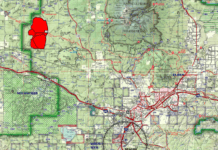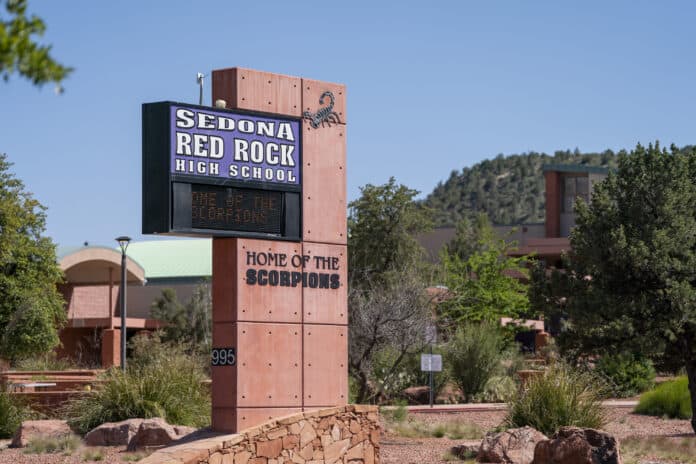The housing crisis and a lack of support from government bodies is affecting Sedona and Cottonwood school children in proportion to the number of students who are homeless and the length of time they have been recipients of support services under the federal McKinney-Vento Act.
“We’re talking about [teenagers] and we’re sometimes seeing them as young as 12 where they’re by themselves on the street in Yavapai County, Arizona,” Yavapai County School Superintendent Tim Carter said. “I hear this across the board. Some schools, because of their socio-economic situation, may have less of a problem than other schools. But it happens in the wealthiest school out there, it still happens.”
The McKinney-Vento Act requires that children who do not have a “fixed, regular and adequate nighttime residence” be provided with transportation to and from school free of charge. This definition includes a number of non-stereotypical scenarios of homelessness, including living in a motel, transitional housing, camping, living in abandoned buildings and other options.
The most common situation in the Verde Valley involves multiple families doubling up in a residence, which Sedona-Oak Creek School District Assistant Superintendent and homeless liaison Deana DeWitt said is an unseen problem.
Administrators with the Clarkdale-Jerome and Beaver Creek school districts have stated that the number of McKinney-Vento students and the length of time they spend in the program has not increased over the last two years.
The Camp Verde School District did not respond to a request for comment.
Conversely, in the Mingus Union High, Sedona-Oak Creek and Cottonwood-Oak Creek school districts, the number of homeless students has increased dramatically in recent years, and the length of time that students are staying in the program is also increasing.
“I’m serving students who live four families in a two-bedroom condo,” DeWitt said. “From some people’s perspective, ‘Oh, well, they’ve got running water, a kitchen.’ But they’ve got 11 people in a two-bedroom apartment and that doesn’t provide privacy, security and structure that you assume a comfortable housing situation would provide.”
Carter said that enrollment in the McKinney-Vento program tends to increase because once students are in the program, they tend to stay there.
“If I hit the lottery and I’ve got a million dollars, I’m going to buy a home … it can literally end that fast,” Carter said. “But we don’t see that, what we’re seeing is that the spiral is downward, not upward.”
In addition to school transportation, the program provides students and families with other support including meals, clothing, fuel cards or simply a discreet place to do laundry or other domestic chores.
“If a student comes to a school and says ‘I’m homeless,’ and we’ve determined that they meet that definition of homeless, there are a significant number of rules that would traditionally apply to a student or family that immediately are suspended,” Carter said. “For example, I don’t have to get transcripts from another school. I immediately get that student in class and create a schedule.”
Sedona-Oak Creek
“I am currently serving 30 homeless students through McKinney-Vento,” DeWitt said. The district has about 750 students enrolled. “I also serve four foster children and five refugees. The programs supporting these children … are similar in support services and educational rights.”
DeWitt said that this is comparable to the number of students served since she began working as the SOCSD homeless liaison seven years ago, when there were 15 students identified. Since then, the program has averaged 20 to 25 students annually. Many of these students are in transient situations to some extent as a lack of available housing resources forces their families to move.
If a family meets the McKinney-Vento definition of homelessness, that family will become eligible for support services for the remainder of the school year, even if their housing situation becomes more permanent. Eligibility is reevaluated annually by homeless liaisons like
DeWitt, who has noticed a troubling trend.
“What I’m finding now is that those families are continuing from year to year … and I’m finding fewer of the transient population in my program,” DeWitt said. “These are more families who have been here for a long time … and aren’t able to find permanent housing for longer and longer periods of time. I have a few families that I have served now for three years under
McKinney-Vento, who still have not been able to find permanent, appropriate housing. That’s what’s changed for me.”
Eleven people living in a two-bedroom apartment in Sedona is not a mental image usually associated with homelessness, so it poses unique challenges for educators such as DeWitt.
“The majority of families that I serve are working families, and almost all of them are employed here in Sedona,” DeWitt said.
SOCSD also serves a handful of homeless families who are camping and provides showers and laundry facilities for those children with the goal of making the kids inconspicuous so they are not ostracized.
“Some of these families are local born, and are experiencing a situation where they can’t afford to find homes here,” DeWitt said. “Many of them struggle with whether we should stay in the living situation that we’re in, where we grew up. But if we go somewhere else, we might be able to have more resources and opportunities for housing. I worry about our businesses, how they’re going to continue to find a workforce. The housing situation has become dire in Sedona, but it’s affecting the entire Verde Valley now.”
Cottonwood
When Gretchen Wesbrock first started administering McKinney-Vento enrollment for the Mingus Union High School District during the 2018-2019 school year, there were about four students in the program.
“Currently we’re hovering around 25,” Wesbrock said. MUHSD enrollment is around 1,247.
“Our biggest challenge is housing in our community,” Wesbrock said. “Waitlists are quite long. A family I was recently working with were told it would probably be over a year to be able to get into low-income housing. I know at one point some of the agencies in town were encouraging families to relocate because of the lack of resources available, particularly with housing.”
Webrock also pointed out that the number of homeless students is likely underreported
because families that double up might not see themselves as unhoused. The issue of underreporting is compounded by inconsistent definitions of homelessness among agencies, which is a major source of confusion for families that can cause them to refrain from seeking out McKinney-Vento services.
For example, at the federal level, the Department of Housing and Urban Development does not consider shared housing to be homelessness. “I have been in this position for about a year now, but I can tell you that it seems that they are definitely staying in that status longer than previous years prior to COVID,” Cottonwood-Oak Creek School District homeless liaison Jocelyn Alvey said.
“What we find is that students are certainly returning multiple years [and] still qualifying for
McKinney-Vento,” Alvey continued. “[But] we have a lot of transition in our community with students coming and going. It’s hard to say whether or not they’re moving out of the program or being withdrawn from the school.”
Cottonwood-Oak Creek currently has 120 students eligible for McKinney-Vento services during the current fiscal year. District enrollment was 1,835 in 2019.




















